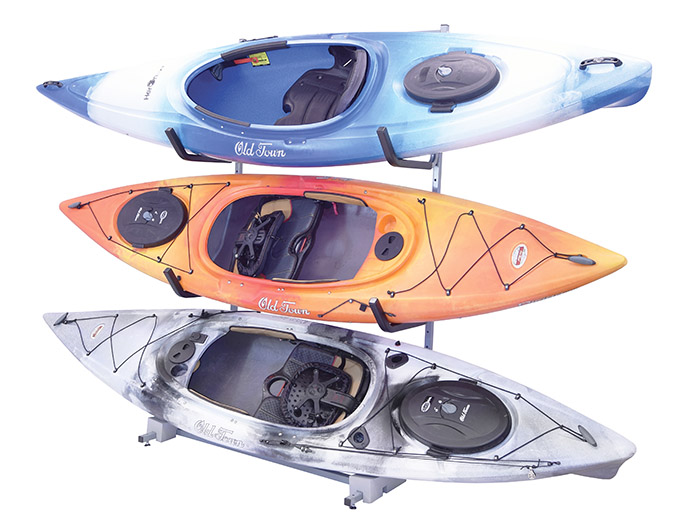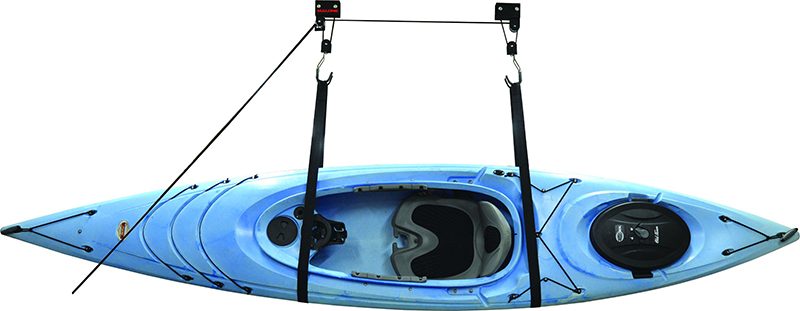The Ultimate Kayak Storage Guide
As winter approaches and water temperatures begin to plummet, many paddlers and anglers start to think about tucking their beloved kayak away for the winter. Yes, it is possible to paddle and fish year-round with the proper experience, gear, and safety protocols. But for the general kayaking population, long term storage is a reality of owning a watercraft.
Before you throw it up on sawhorses or behind your shed, we’ve put together some storage best practices to help keep your kayak in good shape during the offseason. If you are lucky enough to live in a climate where you can enjoy the water year-round, you will find some useful storage tips here, so please consider reading on.
KAYAK STORAGE BASICS
Old Town makes kayaks using rotomolded polyethylene, which is a type of plastic. Polyethylene makes for durable hulls that can take a beating on the water and hold up well to the test of time. However, with improper storage season after season, your plastic kayak may be susceptible to UV damage or hull warping. Below, we focus on two significant kayak storage factors to reduce the likelihood of running into these issues: where the kayak is stored and how it is supported during storage.
SUPPORT YOUR KAYAK
How to store a kayak is one of the most frequently asked questions we see, and one that gets different answers depending on who you ask. Can I keep my kayak on a rack? Can I leave my kayak on the garage floor? Upside down on the gunwales or right side up? The correct answer depends on the type of kayak you have.
SIT ON TOP KAYAK STORAGE
Sit on top kayaks are best-stored deck-side-down on the gunwales, using padded flat bars or straps placed about 30% of the kayak’s overall length from the ends. Sawhorses or 2x4s are acceptable support bars if they are padded. The key is to spread out the weight of the hull to the supports. If you notice the supports denting the hull, you may need to add surface area to the supports. If keeping your sit-on-top kayak inside away from the elements, you may also store it deck-side-up on padded supports or straps that conform to the hull's shape. If keeping your kayak indoors, leave the seat installed to act as lateral support. If keeping your kayak outdoors (deck-side-down), use a piece of wood such as a 2x4 as lateral support. Never hang your sit-on-top kayak by the scuppers or handles, as this will damage the kayak.
Sit-on-Top Kayak Storage Cheat Sheet:
- DoubleU Hull: Found on the Sportsman 106/120, PDL 106/120, AutoPilot 120/136, and all Topwater models. Upside-down on padded bars or straps. If storing indoors, deck-side-up is okay on a padded surface.
- Performance Tri-Hull: Found on Sportsman Bigwater 132, Bigwater PDL 132, and all Predator models. Store upside down on padded bars or straps. The kayak can be stored deck-side-up with straps or pads that conform to the hull’s shape if storing indoors.
SIT INSIDE KAYAK STORAGE
Unlike sit-on-top kayaks, sit-inside models have a large cockpit opening up to the inside of the hull. The cockpit is an open invitation to water, dust, and even small critters to enter your kayak for the winter. Before you store your sit-inside kayak long term, we recommend installing a cockpit cover.
Similar to sit-on-top kayaks, you’ll want to store your kayak deck-side-down, with padded bars or straps to dampen any pressure points. Again, place the supports about 30% of the kayak’s overall length from the ends. For example, if you have a 12-foot long kayak, put the supports about 43” from the bow and stern, with about 58” of the hull between the two supports. Always avoid placing supports on a hatch cover.
Storing sit on top kayaks on their side or in J-style cradles is acceptable when padding is used to dampen any pressure points.
INDOOR & OUTDOOR KAYAK STORAGE
Storing your kayak inside is always preferred. Even without climate control, inside storage removes two crucial factors from the equation: ice and sunlight. Without the possibility of rain, snow, and ice accumulating in the kayak’s hull, you can store your kayak deck-side-down or deck-side-up, whichever configuration fits your space. Additionally, inside storage prevents damaging UV rays from directly hitting your kayak over long periods.
When storing your kayak outside, remember one thing: deck-side-down. Even if covered by a tarp or eave, moisture will accumulate in the nooks and crannies of your kayak. Once there, it can freeze and expand, causing damage to the hull. Whether it’s a sit-inside kayak like a Loon 120 or a sit-on-top Sportsman AutoPilot 136, always store your kayak deck-side-down when it’s outside.
PREPARING FOR WINTER STORAGE
Before tucking your kayak in for the long winter, take a few steps to ensure proper storage conditions.
TIPS FOR WINTER KAYAK STORAGE
Inspect your kayak for any significant cracks, scratches, damaged components, or missing hardware. Now is the time to address these, not when you are about to hit the water.
- Give it a bath. Lukewarm water and soap do the trick. Dry it off, then apply a coat of 303 Protectant to help block UV damage.
- Open the drain plug to prevent condensation and allow for ventilation.
- Make sure all hatches are closed and fastened.
- Remove and clean scupper plugs and valves.
PDL DRIVE KAYAK STORAGE TIPS
- Store the PDL Drive unit inside, keeping it dry and ice-free.
- Remove the PDL Drive thwart bar and install it in the kayak for lateral support.
- Clean and inspect the PDL Drive before long term storage. Now is the perfect time to order spare parts like pins and propellers.
- Check crank arm thread tightness and re-tighten if necessary. Note reverse threads on the left crank.
- Read more PDL Drive maintenance tips.
MOTORIZED KAYAK STORAGE TIPS
- Store motor units inside, keeping it dry and ice-free.
- Inspect the cord and plugs for damage and corrosion, clean and apply dielectric grease.
- Clean and inspect the motor unit for damage. Now is the perfect time to order spare parts.
- Drain the steering motor of all water. Do this by tipping the drive forward so the steering motor vents point downward.
- Remove all batteries from the kayak and the iPilot remote.
DIY KAYAK STORAGE RACKS
Taking a Do-It-Yourself approach to kayak storage can be the best option for a lot of people. Not only can you save money over expensive storage systems, but you can also adapt your storage solution to the space in which you have to work. Here are a few examples of DIY kayak storage solutions.
STORING KAYAKS ON SAW HORSES
One of the most common storage systems you can find. Chances are you already have a few sawhorses kicking around your garage. If not, you can pick up an inexpensive set at any hardware store. Sawhorses are one of the most flexible systems available as you can accommodate nearly any style or size kayak. Adding a bit of padding is as easy as wrapping a towel around the crossbars. You can store additional gear like tackle crates, PDL drives, and paddles in the space under the kayak to make even more efficient use of space.
STORING KAYAKS ON A FLOOR RACK
Homemade freestanding floor racks are an excellent option for the storage of multiple kayaks. Most plans call for two to three levels and can even have two sides, meaning you can store upwards of six kayaks on a single rack system! Popular materials for freestanding floor racks include wood and PVC.

STORING KAYAKS ON A WALL RACK
Wall racks are an outstanding option for smaller and lighter kayaks; think sit-inside recreational models such as the Heron, Loon, and Sorrento. Most wall rack options look similar to the racks you mount on your roof: two J-style hooks that mount directly to a wall to hold your kayak on its side securely.
STORING KAYAKS USING HOISTS & HANGERS
Overhead storage using a hoist and hanger system is a great way to store your kayak without taking up valuable floor space in the garage or basement. Most systems require two pulleys, straps to cradle the hull, and a length of rope.







